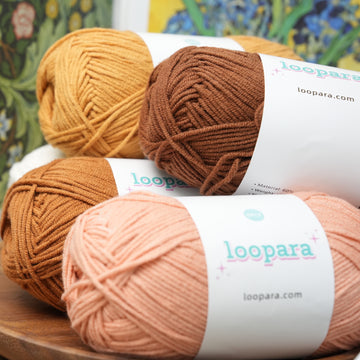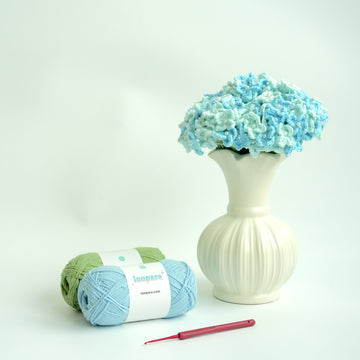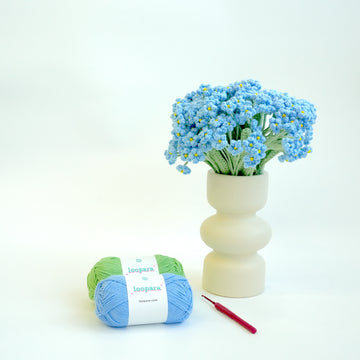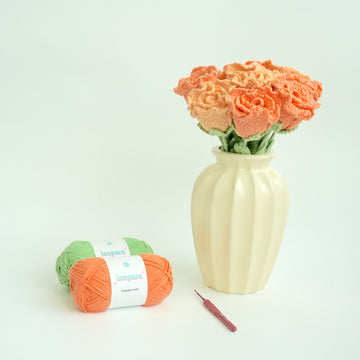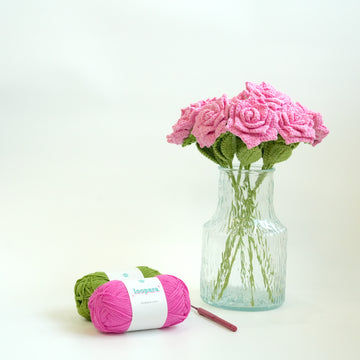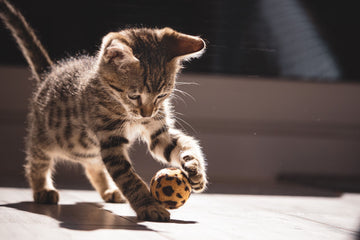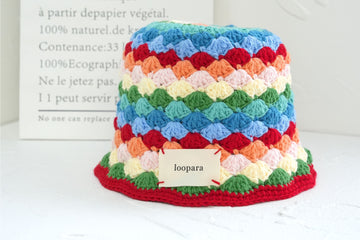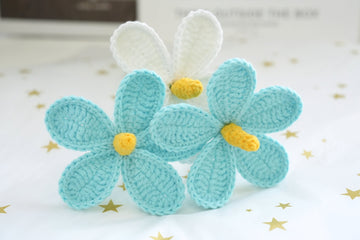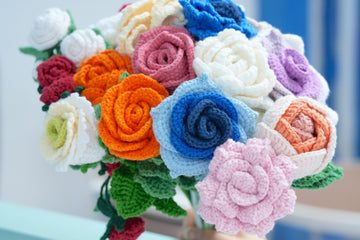These days, most crafts can be made easier with the help of technology. There are sewing machines for sewing and knitting machines for knitting. But when it comes to crochet, there are no short cuts – not yet, at least. So why can’t machines crochet?
That’s what we’re going to discover! We’ll explain why machines can knit but not crochet. And we’ll take a look at the attempts that have been made so far to build a crocheting machine.
Ready? Then let’s get started.
Why can machines knit but not crochet?
At first glance, knitting and crochet might seem pretty similar. After all, they both involve transforming yarn into fabrics. But while there are plenty of knitting machines out there, from home appliances to industrial machinery, no-one has yet built a fully effective crochet machine.
So why is that?
The key difference between knitting and crochet is the way the stitches are formed. To cut to the chase: the structure of knitting is much simpler than crochet. And that means the way a machine needs to manipulate the yarn is much simpler with knitting too.
Number of stitches in knitting and crochet
Knitting uses two basic stitches – knit and purl. Different combinations can be used to create a multitude of patterns, but they’re all based on those two stitches.
With crochet, on the other hand, there are five basic stitches. And once you’ve mastered those, there are over 150 different stitches to learn. That’s before you get into all the extra stitches in Tunisian crochet (a kind of cross between crochet and knitting).
The different stitches can start in any direction. They can skip stitches and double back too. That’s a whole lot more complicated that the knit and purl of knitting.
But it’s not just the number of stitches that are a barrier to the invention of the crochet machine. It’s also the way they’re formed.
The way stitches are formed in knitting and crochet
The easiest way to understand the structure of knitting and crochet is to look at the fabric they produce close up.
With knitting, you’ll see rows of stitches, known as “courses”. These loop onto the tops of the stitches below them. In this way, each stitch lines up with the one above and below it. And the loops form a series of vertical lines called “wales”.
This neat, regular structure is fairly easy for a machine to replicate. It can thread yarn through the series of loops of one course. And when that yarn is pulled upwards, it forms a new series of loops ready for the next course.
The first knitting machine was invented way back in the sixteenth century. And they’ve been widely used for over 200 years.
With crochet, on the other hand, each stitch is formed individually. It has to be finished before it can anchor the next one.
And the way the stitches connect is much more complicated than in knitting too. With crochet, the loops run not only top to bottom but side to side too.
It’s been calculated that the single crochet stitch takes 28 different movements through no fewer than nine different planes of motion. Decreasing is even more complex, requiring 42 different movements through nine planes.
And all those movements have to be completed while maintaining a consistent tension on the yarn. That’s a very tall order for a machine.
Also Read: Knitting vs Crochet: Which is Easier to Learn?
The economic barriers to a crochet machine
You might argue that machines can do all manner of complicated things. Rockets carry human beings into space. And robot arms can perform surgery. So is it really impossible to build a machine that can crochet?
The truth is, it probably isn’t. But whether it would be economical is another matter entirely.
Let’s go back to the comparison with knitting. Because of the relative simplicity of knitting, knitting machines aren’t too expensive to build. And industrial machines can produce large amounts of fabric very quickly.
That means they’re an attractive investment for textile manufacturers. And smaller machines are affordable for home crafters too.
A crochet machine, on the other hand, would need to be capable of highly sophisticated movements. It’s not too much of a stretch to compare it to the level of complexity needed for that surgical robot arm.
Achieving that, if it could be achieved at all, is likely to be very expensive. That would mean anyone producing crocheted fabric commercially would need to charge very high prices.
That might be okay for a really distinctive product. But depending on the pattern, crochet can look a lot like knitting to the untutored eye. And why bother spending a fortune on a crochet machine when you could get a knitting machine for a fraction of the price?
Do crochet machines exist?
If you search online, you’ll find all sorts of people saying there’s no such thing as a crochet machine. For all the reasons we’ve discussed already, that wouldn’t be surprising – but it’s not quite true.
You can find plenty of machines calling themselves “crochet machines” or “crochet gallon machines”. They don’t really crochet though.
But in recent years, researchers have developed a number of prototypes that come much closer to the real thing.
“Crochet machines” that don’t crochet
Some commercial “crochet machines” already exist. The only problem is, they don’t actually crochet.
What they do instead is a technique known as “warp knitting”. This uses hooks, and instead of connecting the wales vertically as in traditional knitting, it connects them laterally.
That produces a different sort of fabric to traditional knitting machines, but it’s not crochet. In fact, these machines can’t produce crochet stitches – not a single one.
Prototype crochet machines
More recently, prototype crochet machines have been designed that are getting closer to really crocheting.
1. The largest crochet machine in the world
The first was built by academics at Hochschule Bielefeld – Bielefeld University of Applied Sciences – in Germany in 2019. It was called “The largest crochet machine in the world” – accurately, since it was actually the only such machine in the world.
The design was based on a knitting machine, but included an extra needle called a “latch needle”. This could be raised, lowered and moved in different directions, allowing it to work more like a crochet hook.
The machine could only produce slip stitches, though. Even these weren’t quite the same as the stitches produced by a human being with a crochet hook. And there were a lot of problems with consistency – the machine frequently stopped working after a few stitches.
2. The Croche-Matic
The Croche-Matic was designed by Gabriella Perry of the Harvard University Graduate School of Design. Its aim was to produce circular crochet for use in amigurumi (crocheted animal toys). The design was published in May 2022 and was a big step up from the Bielefeld machine.
The Croche-Matic could produce “magic rings” of 12 stitches, including chain stitches, single crochet stitches, and increasing and decreasing stitches. More stitches could be built onto the ring, creating crocheted cylinders for amigurumi.
It was an impressive achievement. To produce one single crochet stitch, the machine carried out 30 movements across nine axes. But it still had serious limitations.
It couldn’t make the first stitches in the ring. These had to be stitched by hand, and then fed into the machine.
And the Croche-Matic suffered the same problems with repeating stitches as the Bielefeld machine. Only just over half the stitches were completed successfully. And no more than four single crochet stitches could be formed one after the other.
3. Robotic crocheting
Remember how we said crocheting was as complex as surgery? Well, perhaps it’s not surprising that someone decided to investigate whether a robotic arm could be used for crochet.
In 2023, two academics at the Israel Institute of Technology, Tamar Nix and Aaron Sprecher, published a paper exploring this approach.
They proposed used 3-D scanning of an existing textile to develop a “tool path” for the robotic arm. But it would be the fabric, rather than the robot arm, that moved to create the design.
It’s an interesting idea, but it’s still at an early stage. And for the moment at least, it’s only being considered as a way to crochet architectural textiles.
4. The CroMat
The CroMat was developed by Jan Lukas Storck at Dresden’s Institute of Textile Machinery.
It shares some characteristics with the Croche-Matic, but is designed to produce flat crochet pieces. It can produce slip stitches, single and half double crochet stitches, turns, and increase and decrease stitches.
And, with assistance from a machine operator removing and re-hanging the fabric, it can add new stitches at any point. The creator says this will allow it to produce complex 3D fabric shapes.
It’s still early days – but maybe there’s a glimmer of hope for crochet machines in the future after all.
To sum up: why can’t machines crochet?
Crocheting presents some tricky problems for machines. The sheer range of stitches and the complex movements they require makes automation difficult.
Recent prototypes have shown promise. But even the best of them can only successfully produce a handful of stitches. And it’s too early to say if it will ever be economically viable to produce them commercially.
For now at least, crocheting is one craft that still requires the skill and dexterity of a human being.


